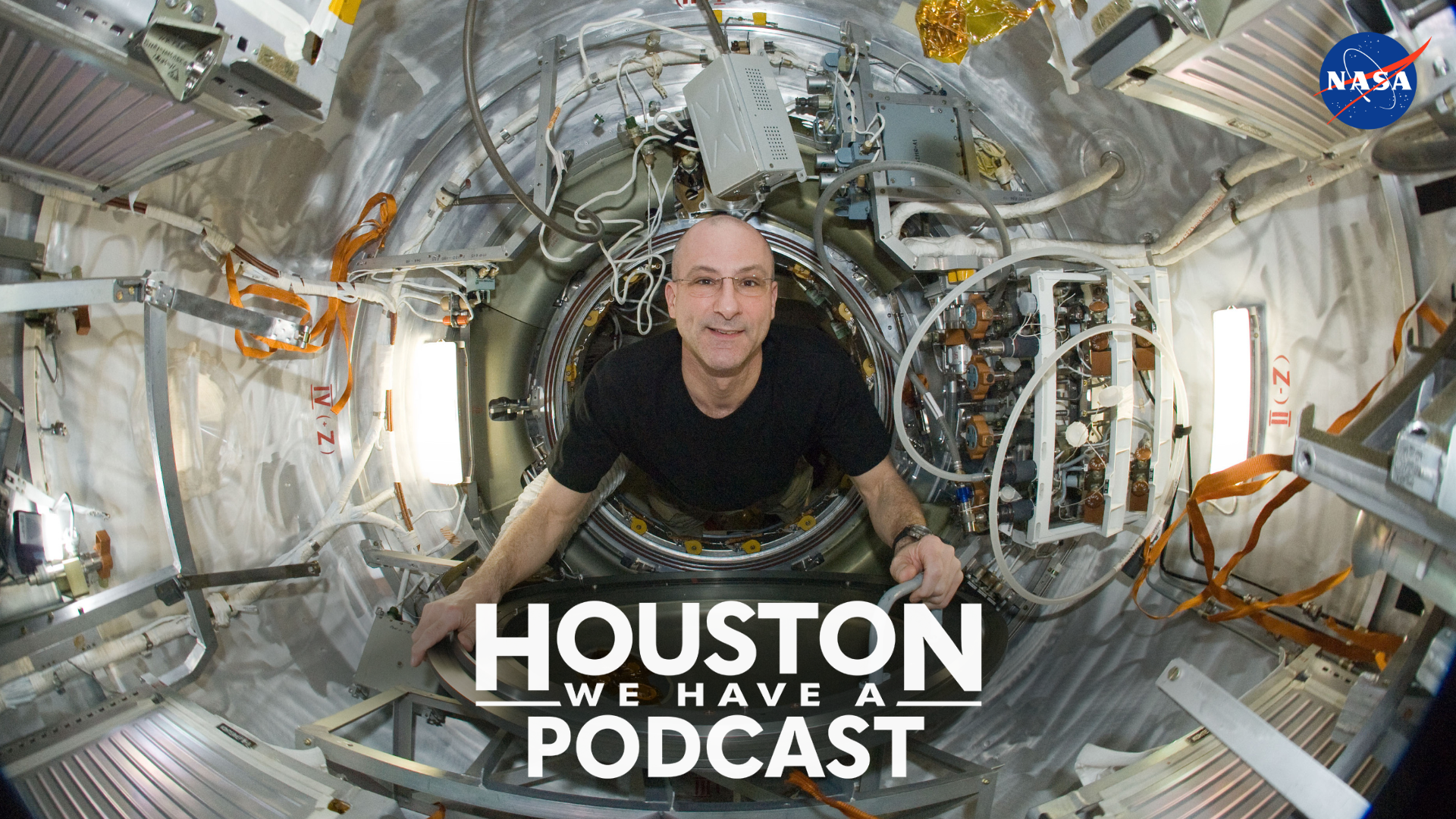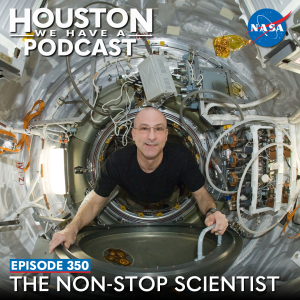
From Earth orbit to the Moon and Mars, explore the world of human spaceflight with NASA each week on the official podcast of the Johnson Space Center in Houston, Texas. Listen to in-depth conversations with the astronauts, scientists and engineers who make it possible.
On episode 350, NASA astronaut Don Pettit discusses his life and career ahead of his fourth flight to the International Space Station. This episode was recorded on July 17, 2024.

Transcript
Host (Kenna Pell): Houston, we have a podcast! Welcome to the official podcast of the NASA Johnson Space Center, Episode 350, “The Non-Stop Scientist.” I’m Kenna Pell and I’ll be your host today. On this podcast, we bring in the experts, scientists, engineers, and astronauts, all to let you know what’s going on in the world of human spaceflight. On this episode, I’m lucky enough to sit down with a veteran NASA astronaut who is about to launch to the International Space Station. NASA astronaut Don Pettit is set to fly on the Soyuz MS-26 mission to station where he’ll stay for six months alongside the crew of Expedition 72. He will launch from the Baikonur Cosmodrome alongside Roscosmos cosmonauts Alexey Ovchinin and Ivan Vagner. This will be Pettit’s fourth flight assignment of his astronaut career.
Pettit was selected by NASA as an astronaut candidate in 1996. He’s a native of Silverton, Oregon, and he holds a bachelor’s degree in chemical engineering from Oregon State University and a doctorate in chemical engineering from the University of Arizona. And prior to his career with NASA, Pettit worked as a staff scientist at the Los Alamos National Laboratory in New Mexico. And now that’s just a glimpse into the wealth of Don Pettit’s spaceflight career, which didn’t even touch on his notable in-space inventions, amazing astrophotography and fun, but educational content. And lucky enough for us here on Earth, he’s heading back to station. Tune in to learn about the seasoned astronaut, all there is to look forward to during his six-month research mission on the orbiting laboratory.
[Music]
Host: Don, thank you so much for coming on Houston We Have a Podcast today.
Don Pettit: It is a pleasure to be here.
Host: We have put you through the ringer this morning. And from our folks listening, you’re here for just a few days before you head over overseas for more training.
Don Pettit: Correct.
Host: And this morning alone, you’ve gone through a whole PAO brief of all things comms for your mission. You just recorded an Astronaut Moment, a video series that we have, which is really great. And so all about science of opportunity. And then, of course, you’re about to head on your fourth mission and people cannot wait to see your astrophotography, all of the science you’re going to share, and hopefully maybe some new inventions. Sorry, no pressure. But anyway.
[Laughs]
Don Pettit: No pressure. No pressure. I mean, that comes with having the job title of being a NASA astronaut.
Host: Yeah. Well, I think let’s jump in and why don’t you tell us about yourself outside of work. You know, a lot of people know you, of course, from your NASA career.
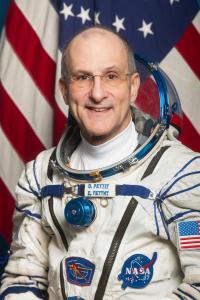
Don Pettit: Quickly. I came from a small logging town in Oregon, Silverton, Oregon, and went to the local cow college and then Oregon State University. There, they’d be disappointed if I called them that, but they’re, they’re the local agricultural engineering college. Went to University of Arizona and then started doing research after that, ended up an astronaut. And, so that’s the first 40 years of my life. And being a NASA astronaut, you work really hard.
Host: So a quick question. What are your interests outside of work?
Don Pettit: I am a maker. I make stuff. And many astronauts, they’ve got sports cars, Corvettes, or they have airplanes. That’s what their hobby is. I’ve turned my garage into a shop/laboratory, and that’s what I like to do when I’ve got spare time at home, is I go in the garage, and I make things.
Host: Do you ever take some time out to make some beer? Do you brew on the side?
Don Pettit: I do brew, I am a brewer of beer. And since starting this training, which is going on two-and-a-half years now, I have not had the time to brew a batch of beer. So I’m doing store bought now. I’ve had to revert to the backup beer, which is store bought. When I finally returned to Earth at the end of this mission, I plan to start up home brew again.
Host: I love it. Okay. So last question I want to ask is, you know, you keep mentioning you’re not driving a sports car. I think I’ve heard about your car, especially here on campus.
Don Pettit: Oh, yeah. It’s a ‘93 Subaru, it got in a wreck. The most important thing was nobody was injured. It was on I-45. Could have been bad, but it wasn’t. But the car is pretty beat up. Most people would’ve had it towed straight to the junkyard. And I had it towed it set in the driveway, and I said, “We’re going to fix this car.” So we spent maybe three or four months of spare time working on this car, and we kind of call it the Franken-car cause it looks kind of like a Frankenstein-equivalent of a car, but it runs really well and it passes all the Texas safety inspections. And so, that’s my drive to work kind of car now. And everybody gives me a hard time because it is so un-astronaut-like to be driving a Franken-car.
Host: I love that. I feel like that’s so you and I need to know, is there really algae growing on it?
Don Pettit: No, that’s my pickup truck.
Host: Okay. I was told about your truck, too.
Don Pettit: Okay. I drive a 1987 pickup truck. I bought it brand new after I graduated from graduate school. And I got my first paycheck, real paycheck, not living off of student wages anymore, my first real paycheck. And I got this pickup truck, and I do all my own mechanic work on it cause I’m a maker and do my own body work, even though I’m not very good at body work. And there’s cyanobacteria, also known as blue-green algae growing in the paint on my truck. I’ve painted it a couple of times. And the last paint choice was not a really good paint choice for a motor vehicle. And this blue-green algae kind of moved in. And depending on the weather, my truck could turn a little bit on the greed side. And people give me a hard time about that. And I say, “Look, my truck consumes carbon dioxide. It generates oxygen when it is parked. It is reducing the carbon footprint of a motor vehicle.” And that is technically true from a practical point of view. Of course, it doesn’t do much, but it’s my justification for having a truck with cyanobacteria growing in the paint.
Host: I have so many things to ask and say to that, it’s so, you, I love it. Helping the Earth both in-orbit and on the ground with your truck. Okay. Well, oh my God, that was so funny. I’m sorry. Okay. So you mentioned getting your truck after getting your first paycheck. Was that at Los Alamos National Lab?
Don Pettit: Yes. Yeah.
Host: Is that when you started to think of space being in your future? Or did you always think of that even as being a kid?
Don Pettit: Well, as a little kid, I saw John Glenn go into space and I thought, wow, that’s really cool. I want to be an astronaut. Just like probably 90% of all little kids nowadays, right? And you file that away in the back of your mind, and then you get captivated by science and technology. And Earth speaks to you from a point of view of, wow, what’s happening with that row of ants? Why do these bees flock around that flower? Or why does rain drip leak from the gutter in the way that it’s leaking it from the gutter on the side of the house? And you make these observations, and it speaks to you, and you try to figure out what’s going on. And then at graduate school, I was finishing up and NASA had an announcement for a new class of astronauts, which I hadn’t done in years and years. This was 1984, I think. And I thought, wow, I’m qualified to do that. I’m not a pilot military-type, but from a mission specialist, scientist, engineer-type, I’m qualified. So I put in an application.
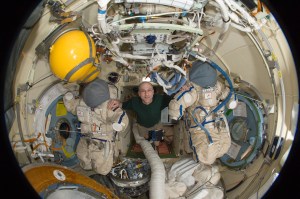
Host: And so what was the process like for you? Was it just that first app or many apps?
Don Pettit: You put in an application with about 6,000 other people, and for some reason or another, I got in the top 120 group. I came in to JSC for an interview and a really thorough medical exam.
Host: There was definitely a reason, by the way.
Don Pettit: And then you get the reject letter and it’s like, wow, I’ve been bitten by the space bug. I now have firsthand knowledge of what it’s like to be working at the Johnson Space Center at what astronauts do. And this is something that I am not going to take rejection. I’m going to keep applying. And about three years later, there’s another astronaut selection and I put in my application, and gosh, I made it in the top 120 again. And then I got the reject letter. And I kept repeating this process until the fourth time. And by then, I’d married Micki. And for some reason or another I got the phone call that said, “Hey, if you’re still interested in being an astronaut, come to Johnson Space Center.” And my wife thinks it’s because I was married at that time. And there could be a good thread to that because becoming married gives you a certain level of maturity and focus, and maybe that’s what I needed in order to get into the Astronaut Office.
Host: That’s interesting. It kind of ties back to, you know, we’d seen you on other interviews. You mentioned your time at Los Alamos is that’s where you kind of learned to grow up, right? So to speak. And then it took you to your fourth time, and then you’re married to maybe really grow up, right? Well here we are in Houston. Let’s talk about NASA Group 16 and the Sardines. He walked in, Don Pettit walked into the PAO, the public affairs brief this morning to talk all things comms for this mission, and he had a sardine bag. And I called it out right away that I loved it. But tell us about the astronaut group.
Don Pettit: My group was the 16th group of astronauts selected in 1996. There was 35 NASA astronauts and nine international astronauts in my group. The largest group to date, 44 of us, we show up and the astronaut class before us gets to give you your call sign, gets to give you your name because there’s so many of us and they crammed us into a couple of small rooms that we referred to as the bullpen where you’d be in an office with like eight other people. And somebody said, “Hey, you’re crammed in there, like sardines.” And that became the name of our class.
Host: So Don, you’re a three-time spaceflight veteran and no stranger to station or Soyuz. So let’s recap some of your missions. Can you tell us about your first spaceflight where you went up on Space Shuttle Endeavor and then you came back on a Soyuz?
Don Pettit: Yeah. That was a mission that at, for the time was going to be one of the shortest missions to date on space station. We launched in November, and in some versions we are going to come home in in mid-January. And then it got slipped to mid-February, and then Columbia happened, and shuttles were grounded. And for about two-and-a-half years, our mission was extended to five and a half months, and we came back in our Soyuz spacecraft.
Host: So you performed two space walks with Ken Bowersox, who now oversees the Space Operations Mission Directorate. So still here at NASA. That’s pretty cool. You performed two spacewalks with him. Are you planning to do any on this mission?
Don Pettit: We have officially one spacewalk planned on this mission. We may have one or two more added, and there’s four crew members who are all trained up, ready to go for spacewalks at Mission Control figures out who are the best two people for any one spacewalk to go out the door. So I’m ready to go out the door. My three other colleagues are all ready to go out the door and we’re happy to do whatever the mission planners want.
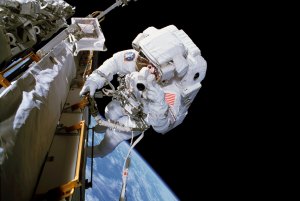
Host: Okay. And flip-flopping back. Can you tell us about your return to Earth on your first mission?
Don Pettit: Oh, yeah. The Soyuz, it was docked to station at the time. This was where crews were swapped out with space shuttles and the Soyuz was an independent vehicle in case something happened to the space shuttles. We had an alternate way to return to Earth and we needed that for our mission. During Expedition 6, that particular Soyuz, it was Soyuz TMA-01. So it was serial number 01 of a brand new cockpit upgrade. The Russians had not upgraded the cockpit for many years. This was the new improved version and we had a malfunction coming in.
Host: Do you want to talk about when you went to Antarctica in between your first and second?
Don Pettit: Yeah. Antarctica, there’s a NASA National Science Foundation joint-funded endeavor called ANSMET, Antarctic Search for Meteorites. And they go to Antarctica every Antarctic summer, which is November, December, January, February time period for us in the Northern Hemisphere. And they go way out on the ice, not living at McMurdo, not in Palmer Station, not at the South Pole. You get deployed in Scott tents. And these are tents that are patterned after what Robert Scott used in his 1911 expeditions to Antarctica, which by the way, he froze to death in one of these, but it’s still a timeless tent design. So we’re camped out maybe 200-300 miles from the South Pole. We’re dropped off by a C-130 and you stay there for six weeks, and you gather meteorites.
Host: So keep going along on your breadth of experience and spaceflight experience. So first, um, we had just spoke about your first mission Expedition 6, that was from November of 2002 to early 2003. In between you went to Antarctica. Thanks for filling us in on that. And then your second time on Endeavor, so your second spaceflight, you went on Endeavor as well. Can you tell us about STS-126 in 2008?
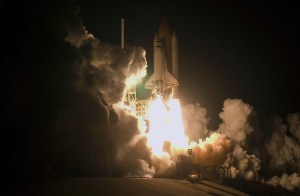
Don Pettit: STS-126, this was the first time I flew round trip on a space shuttle. And our mission was extended because of bad weather at KSC. It was a 16-day mission, which at that time was a really long mission for space shuttles. If I remember correctly, 18 days is probably the longest space shuttle mission. And we brought up outfitting equipment for space station. We brought up the regenerative life support system, which is what the NASA engineers like to call it. I came up with a different name. What this life support system does, it starts off with a toilet, goes through a number of little processing things that are about the size of a refrigerator, and then it ends up at the galley. And the water from your urine ultimately ends up in the galley, all purified and nice. And you use it to make your dinner. And I referred to this not as a regenerative life support system, I called it the coffee machine because it turns yesterday’s coffee into today’s coffee.
Host: Did you coin that term?
Don Pettit: Yeah, we did a down—
Host: Inventor, content creator, like everything.
Don Pettit: Yeah. We did a down link where we had during STS-126, we set everything up and we ran the first few liters of urine through the urine processor. And we actually have a picture where us as a crew are holding it and it’s crystal clear in a clear bag, everything pure, everything nice. It has a certain yuck factor, but from a practical point of view, we need this to expand into the solar system and I called it the coffee machine.
Host: I love it. And I’m sure our listeners will too. So on your second mission that you just spoke about, which was STS-126, and you spent 16 days on the International Space Station, you’re no stranger to spacewalk and you operated the robotic arm for all four those, right? And so hopefully, or maybe we’ll see you on a spacewalk on this mission.
Don Pettit: You know, who knows? I’m trained up to either fly the arm or do the spacewalk. I’m happy to do whatever the mission planners at MCC want the crew to do.
Host: And now onto your third and not final mission, which took place from December 2011 to July of 2012. Can you tell us about that?
Don Pettit: That was a normal mission, meaning I flew up on the vehicle that I was supposed to, I flew down on the vehicle. I was supposed to. We did not do any spacewalks, which means we can concentrate on utilization, we could concentrate on scientific research, and we could concentrate on engineering research.
Host: And so there was something special about that six months in space.
Don Pettit: Oh, I know what you’re referring to. What happened was the beginning of commercial space interacting with the space station. So SpaceX Dragon, the first SpaceX Dragon vehicle that actually came to space station happened. It was called D-1, that was its mission name. And I was flying the robotic arm that captured that vehicle. At that time, these vehicles fly within maybe 30 feet of station and just kind of hang. And then you go there with the robotic arm, and you snag it with a robotic arm. Then you bring it in to one of our docking mechanisms. And I flew the arm and I captured the Dragon D-1.
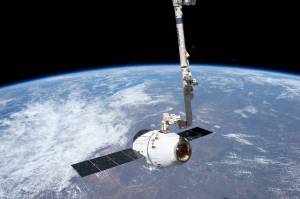
Host: Now you just mentioned another term that you had coined. Was there a—?
Don Pettit: Oh, I called down after capturing it. I called down to mission control and I said, “We have a dragon by the tail.”
Host: I love it. We love it. Don. So how are you feeling about going back to station for a fourth time?
Don Pettit: I am excited. I’m jazzed. I’m ready to go. I’ve been trading for almost two-and-a-half years. Tomorrow’s my last day here at Johnson Space Center. And then I go to Star City, Russia, and I’m ready to be back at my home away from home.
Host: And speaking of that, you said you come alive when you’re on space station?
Don Pettit: I do. For some reason, being in the orbital environment just energizes me. I feel like I’m 20 years old again with the wisdom of somebody much older.
Host: In what ways do you think it’s changed since you’ve last been up there in 2012?
Don Pettit: Good question. I’ve had some communication with a crew that’s currently on orbit that have been there a number of times and asking them, “Hey, what’s different?” And the basic answer is, it’s still the same place. There’s more junk, you know, more cables, more snarls, more stuff. It’s like your garage after some period of time, it’s filled with stuff. It’s more efficient now in terms of how to handle your daily routine. We’ve got better planning tools, both at Mission Control and then what the crew sees on orbit, so we can more efficiently execute the operational content of station. So the changes that I have gotten feedback on, they’re changes that are for the good. I
Host: And speaking of bringing up lots of stuff on station and how much stuff is already up there. We can’t wait to learn about maybe some new equipment you’re going to bring up for your astrophotography. A lot of folks here on the ground can’t wait for that. But first, I want to talk about inventions. So you’re also known for your in-space inventions. Can you tell us about one you’ve created in the past?
Don Pettit: Oh, well, the, the Zero G Cup had invented on space station, because like Jonathan Swift said, necessity is the mother of invention. And when you drink all your fluids from the equivalent of a juice bag, it’s not the same effect as what you are used to consuming your beverage from a cup or a or a mug on Earth. These are gravity machines and they don’t work in a weightless environment. And got this idea using surface tension. And I worked with a colleague from Portland State University, Mark Weislogel, and we made together the first Zero G Cup out of stuff on station. He was at Portland State. I was on orbit during STS-126 and brought the space cup to fruition, and then it was subsequently patented.
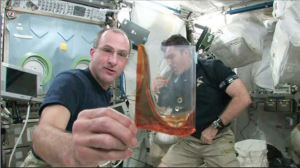
Host: And that name, Mark, sounds familiar. Did you work with him with bringing the… It was through ISS National Lab, but it was slime in space.
Don Pettit: I did, yes, the slime in space thing. I worked with a number of people on that from the ground perspective because I wasn’t there. People were mostly concerned about, is this going to make a mess and, possibly destroy things on station when you release all of this green slime. And we worked with the NASA safety engineers and came up with an attractable plan for doing the slime in space.
Host: Okay. And were you involved because of your research on fluid?
Don Pettit: You know, I think I was just walking down the hallway and they needed an opinion of something and it’s like, “Hey, you, go in this room. Tell us about how we could do this.”
Host: Is that how things work around here?
Don Pettit: A lot of things work that way. You need an expert to go talk about a subject to add. If you happen to be walking down the hall at that time, it’s like you, you’re flying to North Dakota and you’re going to be talking at this conference.
Host: Hey, I love it. So overarching, you’re heading to station very soon as part of Expedition 72, what are the overarching mission goals?
Don Pettit: The mission goals, we have all the programmatic ops that are coming with the mission, and they don’t really crystallize until maybe the last three months before your mission and Expedition 72 officially won’t start until the middle of September. So what we are planning to do is still in the process of being formulated. We do know there’s a whole host of scientific investigations. I’ve been doing training on some of them that we know will be there. There will be investigations that maybe will be there or maybe won’t be there. And then spacewalks. Initially there’s going to be one spacewalk, and now there may be two or three or four spacewalks. It just depends on how the mission profile unfolds. So being ready or being willing to go with the flow and do whatever shows up on your plan is key to having a fulfilled space mission.
Host: And so you’re going to be spending your time up on station helping to conduct hundreds of research investigations alongside the crew of Expedition 72. Can you tell us a bit about the science of opportunity? So while you’re doing all those research investigations that NASA and ISS National Lab are sending up there, when you have time on your free time while you’re up there, how are you going to use that time science-wise?
Don Pettit: Okay, first I want to talk free time versus off-duty time. And on station, I don’t really, you don’t have free time. You have time when you’re either on duty or you’re off-duty. And off duty has more of, you’re on an operational vessel and you can’t A. Get off of the vessel. And B. you have to be ready to get called onto duty at the drop of a hat. And so you have your off-duty time. What do you do during your off-duty time? And you’ve got to sleep, you’ve got to make your dinner. There’s personal hygiene. You need to stay connected with your family on Earth. But there is a significant moment where you could do whatever is possible on space station. And what I choose to do is science of opportunity. I like to do investigations simply because I am there and I can, and these are observations that are spawned by the orbital environment. Again, because you are there and you see something that’s, wow, that’s crazy. And then you say, “Let me poke it. Let me take a picture of it. Let me mess with it in a little different way.” And that becomes the science of opportunity.
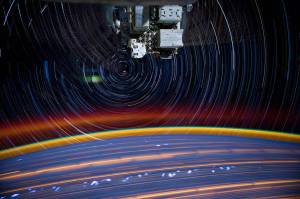
Host: So now in your off-duty time, you are well known for your astrophotography, your incredible astrophotography. And you know, I joked that Matt Dominick is putting out some really great photos, and I know some people on X have been talking about how they’re excited to see you up there and see what pictures that you send down too. And so I think a lot of people are, are curious to know, is there any new equipment you’re bringing up that we should look forward to?
Don Pettit: Yes. Astrophotography or basically photography in any form is one of my loves of life. And everything I do, ever since I was probably seven years old, I’ve documented with photography and being on space station is this amazing environment. And you document what you see and you document inside and outside you document that through photography. And astrophotography, I do that here on Earth. I’m an amateur astronomer and it just naturally moves to space station.
What I have talked NASA into doing, not just for me, but for the space station program, is flying a number of really cool lenses that are going with our new camera system that we have on station that are optimized for nighttime imagery. And one of the lenses is optimized for doing imagery of cities at night. And cities at night, backing up to Expedition 6 in 2002, you try to take a picture of a city at night, amazing views from orbit, and they’re all blurry because the shutter speeds are, you know, around one second, maybe one-and-a-half seconds, and you have a handheld camera and orbital motion. And the cities at night are blurry. And I cobbled up a homemade tracking system from what then the, the old IMAX movie camera mount that I could precisely move with a bolt being driven by a drill driver. And this is known by amateur astronomers to be a barn door tracker. And it allowed me to manually track out the orbital motion and take longish exposures of cities at night. And from Expedition 6 came down the first really in-focus images of cities at night, some of them with a resolution down to 40 to 50 meters.
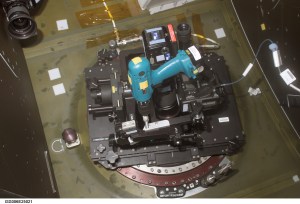
And since then, the whole concept of imaging cities at night has blossomed. And now one of the main requests from the Crew Earth Observation people from outside researchers say, “Hey, can you get a crew member to take a picture of this?” One of the most requested items are cities at night, primarily cause of the scientific value of looking at how human beings sprinkle their light bulbs out at night says a lot about your culture, says a lot about your geographic situation. Says a lot about how well you can recover from natural disasters, hurricanes, flooding, that kind of thing. And it’s a natural topic to investigate from orbit that you could get data on how the state of human beings are. And I talked NASA into flying this new lens that it will have a factor or two more light gathering capability than the current lenses we have on station. And it will allow us to get sharper images of cities at night. So that’s just an example of one of these lenses optimized for nighttime use of cities at night. And it will transcend my expedition. It will be up there for anybody and everybody that’s on space station to continue to do imagery of cities at night.
Host: We are so excited to see these images come down. Is there a city that you’re looking forward to? This might be a silly question, but can you see Silverton at night?
Don Pettit: Actually, Silverton doesn’t have much of an optical signal at nighttime, which in some respects is a good thing. It’s really hard to see. Salem, which is close to Silverton, you can see the city lights of Salem. It’ll be interesting to see now, 12 years later, since the last time I was on orbit, maybe I could see Silverton at nighttime and you could make the judgment, is that a good thing or a bad thing in terms of light pollution? Cause the brighter your city and the greater its view from space, the converse of that means if you’re in that city, that means you can’t see the splendors of space anymore.
Host: And so inventor from space, astrophotographer from space. And something you’re also amazing at is being a content creator from space, even before social media was really a thing. And speaking of social media, you’ve got quite a following. What can we or your followers look forward to you sharing from orbit to us on the ground? Are you planning to send some more educational videos down, thinking of things in the back, your knitting needles, the water sphere videos?
Don Pettit: Yeah. I’m planning all the above. I am flying some more knitting needles. And I’m going to use it for static charge experiments, not because I know how to knit or I’ve got the off-duty time to knit, I’m going to use them because you could rub them with various fabrics and put a static charge on, and then you can make things dance around in a weightless environment in a manner that you can’t do on Earth. That’s one expansion of what I have done on prior Expeditions that I’m planning to continue.
Host: And you’ve even shared how to repair a watch in space. And I think a lot of people might want to know, are you bringing back Saturday Morning Science?
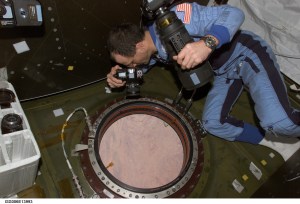
Don Pettit: I am. And I’m going to rebrand it though. I’m going to call it “Science of Opportunity.” So it will still be, you know, a Saturday morning kind of thing that I could downlink, but I like the term science of opportunity. It explains it. I think it explains it better than Saturday Morning Science.
Host: As part of this rebrand, can we please use the old intro from Expedition 6 and put it there as a throwback?
Don Pettit: Yeah, we can. In fact, I forget what the what the intro is. Oh, actually that intro came, that was an intro done by MCC. So, yes. We could do the old intro and make that part of the rebranded Saturday Morning Science.
Host: I love it. Don, it’s been really great talking to you. It’s really an honor talking to you with all your spaceflight experience and me as one of your followers and I know a lot of our folks who are space enthusiasts that listen to this podcast are very excited for this episode. The last question I have is, are you so excited and what’s that back to station feeling like? What’s that going to be like?
Don Pettit: It’s going to be like going home. The feeling of being weightless and your ability to move around is like riding a bicycle. Once you learn that you could jump on a bicycle and maybe you won’t ride it like you did when you were 20 years old, but you could still ride it and you could still expertly operate the bicycle. And I found in my previous flights, when you get reintroduced to weightlessness and the hatch opens and you expand into space station, it’s like, “Wow, I am home.”
Host: Well, we can’t wait to see that look on your face when you enter station and we’ll be cheering you on from down here on the ground.
Don Pettit: And I will have more of what I call “techno stories” from space.
Host: Love it. We can’t wait. Thank you so much for joining us today.
Don Pettit: My pleasure.
[Music]
Host: Thanks for sticking around. I hope you learned something new today. Our full collection of episodes is on nasa.gov/podcasts. You can also find the many other wonderful podcasts we have across the agency there as well. And you can follow Don’s six-month mission through his eyes and camera lens on his X, Instagram, and Reddit accounts at @Astro_Pettit. On social media, we are on the NASA Johnson Space Center, pages of Facebook, X, and Instagram. Use #AskNASA on your favorite platform to submit your idea or ask a question, just make sure to mention it’s for Houston We Have a Podcast. This episode was recorded on July 17, 2024. Thanks to Will Flato, Dane Turner, Abby Graf, Dominique Crespo, Chelsey Ballarte, Leah Cheshier, and Gary Jordan. And of course, thanks again to Don Pettit for taking the time to come on the show. Give us a rating and feedback on whatever platform you’re listening to us on and tell us what you think of our podcast. We’ll be back next week.
This is an Official NASA Podcast.




























